The MGA With An Attitude
THERMOSTAT, ALTERNATE MOVING SLEEVE TYPE - CO-103D
Here's a new part (new to me) that was brought to my attention in mid May 2004. Thanks to Phil Bates in Idaho for the notice and the pictures. This is Moss Motors part number 434-155. It has a bypass closing sleeve and is a 160°F thermostat. This is specified for the Austin Healey 100 and 3000, and for the Triumph TR2 through TR4A cars, but it works for the MG also. Unlike the original moving sleeve thermostat, this one can be purchased today (at least when this article was written). Pity that it is only available in 160°F specification. If anyone knows where this type thermostat could be purchased in 180 to 190°F operating temperature, please holler.
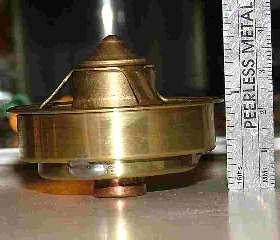
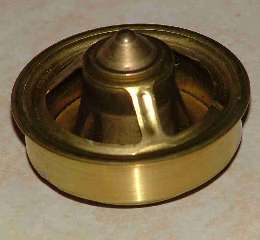
For this thermostat the sleeve is in the full raised position when cold, nearly touching the top mounting flange. The closure to block fluid flow is between the inner cylindrical body and the top flange. When this unit approaches the preset operating temperature and begins to open, the sleeve moves downward (along with the cylindrical body) to block the bypass port. The port opening is 3/8" down the wall, and 3/8" tall (bottom of bypass port 3/4" down the wall). This thermostat has a sleeve about 7/16" tall, and 1-29/32" diameter (same as the optional blanking sleeve). This will overlap the top of the bypass port slightly when at rest (cold). This is no big deal since the port opening is quite large relative to the smaller drill hole within the port.
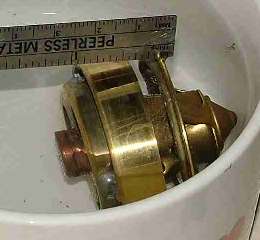
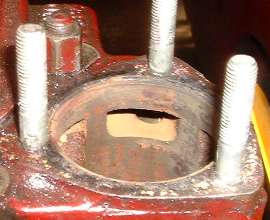
When hot and fully open the 7/16" tall sleeve needs to be fairly accurately positioned to completely cover the 3/8" tall bypass port. This reportedly works okay as the opening distance between the mounting flange and the top of the sleeve is 5/16" or just a smidge more. This will block all flow above the ring when it is within 5/16" of the top flange. Like the original moving sleeve thermostat, the coolant flows through inside of the moving ring where there is flow space between the sleeve and the inner cylindrical body.
HOWEVER, .... The inner cylindrical body of this unit is slightly larger diameter than the bellows of the original type moving ring thermostat. The resulting flow space between the body and the ring is about 0.6 sq.in vs 0.8 sq.in. for other thermostats. While this will infer a relatively higher flow restriction for the thermostat, it is not known (yet) if this may have any significant adverse effect on overall cooling. There are a lot of other restrictions to flow throughout the cooling system, so this little extra restriction may or may not be of significance. The only way to know for sure would be to measure total flow through the cooling system at a fixed engine speed with both thermostats. Even then a very small difference in total flow may not have much effect on overall cooling efficiency.
The best test would be to run two identical engines with different thermostats in fixed laboratory conditions. Also maybe switch the thermostats and run the test again to be sure the results are repeatable (engines really are identical). I don't have facilities to do that. The next best test (perhaps better in the real world) would be to run one car on a hot day, and then switch thermostats and run it again under identical driving conditions to see if there is any noticeable variation in coolant temperature. I might be encouraged to do that someday, but weather conditions are not currently suitable (mid October in the north). So far I have only a single user report saying that this thermostat works as well as (or possibly better than) the "Chevy" type thermostat used in conjunction with the blanking sleeve. I wouldn't want to jump to any conclusion based on a single report without some controlled testing. I will follow this with an additional article on the theory of cooling system operation. See articles CO-200a and CO-200b).
Addendum 10/18/04:
Pat Jenkins is a thermostat engineer for Robertshaw.
At 08:38 PM 10/17/04 -0600, Pat Jenkins <jenko@comcast.net> wrote:
>"This basic Thermostat (without the extra ring soldered to it) is called a Balanced Sleeve thermostat and was invented and produced by my company, Robertshaw, until about 5 years ago. We sold the product line to Cooper Automotive who produces the Balanced Sleeve Thermostat in Mexico.
>
>The extra brass ring is added to the Balanced Sleeve thermostat by a distributor who modifies this thermostat for use in 'British' applications. As a Thermostat Engineer, I might be concerned about the flow area that exists between the brass ring and the thermostats sleeve. All the flow to the radiator must get through this annular area. It seems fairly restrictive".
Addendum 6/18/20:
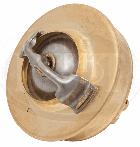
Here is another example of a modern wax-stat thermostat with a moving ring bypass blocker. This one moves from top down when opening. It can be found at https://www.sngbarratt.com/English/#/UK/parts/52d484f9-492e-42b3-9bd2-c1df6f288830.
|